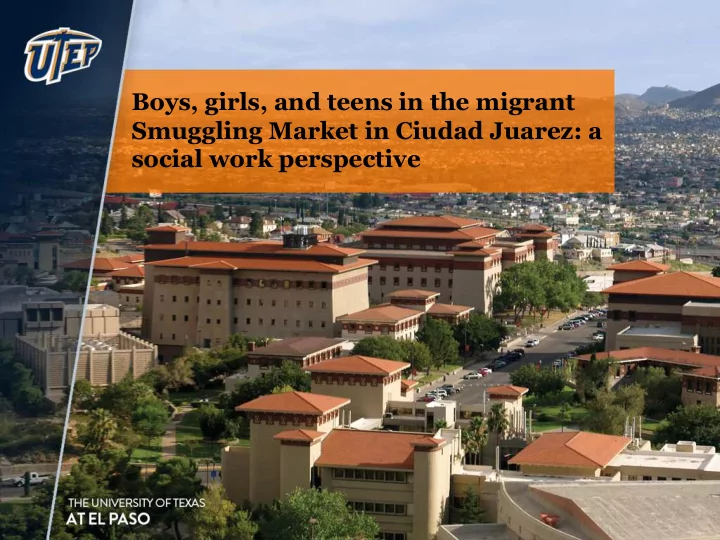

Boys, girls, and teens in the migrant Smuggling Market in Ciudad Juarez: a social work perspective
Unaccompanied Minors on the border • While numbers of Honduran, Guatemalan, Salvadoran children are significant, apprehensions of Mexican child migrants rival those of the other 3 countries • Many of those caught have tried to cross multiple times • Pew Research: in 2014, out of 11,000 apprehensions of Unaccompanied Mexican Minors, only 24% had been arrested for the 1 st time. – 76% indicated the had been apprehended multiple times – 15% of the children had ben apprehended at least six times.
“Circuit Minors” on the border • A FY2014 analysis showed over 1/3 of the unaccompanied Mexican children apprehended at the border were from Tamaulipas and Sonora (Pew Hispanic Research) • Chihuahua’s children also figure in the statistics, the El Paso sector being an active region for migrant smuggling activity. • 75% of the children assisted at the Cd. Juarez shelter were from neighborhoods in the periphery of the border fence.
Who are the kids working in migrant smuggling? • “Niños de circuito”: term used for juveniles whom drug traffickers and migrant smugglers employ as couriers and guides. • The term refers to their ability to cross the border back and forth. • Minors living on the Mexican side of the border, in the proximity of the US Mexico divisory line, primarily in districts or colonias historically marginalized with limited services. • Ages range from 6 to 17 years of age. • Majority of those involved are males. • Guides, lookouts; as they grow, shift to other roles
El Paso trends with Circuit Minors • Numbers and trends appear to be smaller size, scale than in other sectors along the US Mexico border • Boys and girls between 6 and 17 years of age • Cross the border back and forth repeatedly, • Awareness and knowledge of border routes (local residents)
What are the risk factors of circuit children in Juarez? • Minors from local, Ciudad Juarez families • Residents of colonias or zonas expulsoras presenting high incidence of criminal activity – Felipe Angeles, Ampliacion Felipe Angeles, Anapra • Members of single parent, mixed and extended families • High drop-out levels • Addiction (emerging many times from their participation in smuggling activities)
Colonias with largest incidence of circuit minor residence
What are the reasons leading to participation? • Conditions of structural vulnerability • Poverty and violence • Lack of employment, education, recreational opportunities. • Geographic proximity with the US and demand for smuggling services • Children from Mexico can be returned to Mexico within hours of their apprehension, often without facing charges • Gender perceptions (particularly young males)
How are the children recruited? • Similar pattern as adult recruitment: Friends and families are already involved • Invitations to join by peers, community members • Intimidation and threats by older, more experienced smuggling facilitators • Entrepreneurial spirit; desire to be independent, support family (specially when younger siblings, single head of household)
Challenges/vulnerabilities faced by youth • Initial excitement turns into boredom soon • Inability to articulate desire to exit market/ develop a safe exit strategy/have a plan • Power differentials between minors/older facilitators • Inability of parents, siblings to provide assistance, support • Communities, place of residence unlikely to change (limited opportunities, alternatives, etc.) – Children likely to return/remain in criminalized activities, shift markets (drug trafficking, other activities) • Oppositional interactions with authorities, mistrust and fear – Children may be challenging, aggressive, create stories to scare
How can we help? • The work the children perform in smuggling often falls into the definition of forced labor and human trafficking . • Work alongside children, organizations to determine potential alternatives and opportunities • Risk factors, recruitment dynamics and roles performed by children as rooted in structural inequality – Without changes, numerous children will continue to retun to unsafe environments
Intervention Program for Circuit Minors in Cd. Juarez Circuit Minors on follow-up programs Cd. Juarez Selter, 2014-2016 132 103 85 AÑO 2014 AÑO 2015 AÑOS 2016
Prevention Initiatives in Juarez Multidisciplinary, systematic approach (social work, psychology and education) Individualized attention Group intervenBon Community IntervenBon
Individualized attention projects
Juvenile Referral Program • 2014-2015 • Detection and retention of children eligible for criminal prosecution given their involvement in smuggling. • Initially implemented in South Texas, extended to other border sectors. • JRP minors detained for longer periods than unaccompanied minors, often in high security facilities. • Civil rights organizations concerned over legal rights of children and their potential referral to prosecution • Estimated over 500 children went through program.
How can we help? • Development of tools to improve screening of minors on both US and Mexican side – Agencies with a vested interest in child welfare, victim identification programs should be screening and identifying victims (not law enforcement) – Screening protocols for minors to communicate in their language and perspectives should be developed
Contacts Universidad Autonoma de Derechos Humanos Integrales Ciudad Juarez en Accion (DHIA) • Professors Fernando Loera • Blanca Navarrete and Carlos Zavala B.Navarrete@pdib.org • fdoloerag@yahoo.com.mx University of Texas at El Paso zavala-carlos@outlook.com • Gabriella Sanchez gesanchez4@utep.edu
Recommend
More recommend